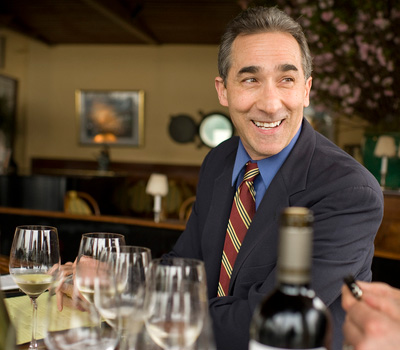Joe DeLissio joined the team at Brooklyn’s The River Café in 1977 as “the guy who ordered the liquor.” He started taking wine classes, including Kevin Zraly’s course, and several years later became the wine director as well as the beverage manager, roles he maintains to this day. When The River Café was closed due to flooding from Hurricane Sandy, DeLissio had to inventory a lot of wine that was unsalable, the labels destroyed but the wine inside the bottles still okay. In the end, he got to taste some older wines he’d been buying for the restaurant and decided to make some changes in the list. Eventually, when The River Café reopened at the end of February 2014, he had upped the number of selections to 900.


How did your strategy for building the list change?
The wine program is a little different now. We used to have a separate reserve list, now we only have one list—about 18 pages, not a telephone book. We managed to find some space in height when we redid the wine room, and we’ve increased from 700 to 900 selections. We resculpted everything. I asked myself, how many wines do I need to show what California cabernet is about. We still have a page of classics, of older, rare wines, but on the regular cabernet page I only have six. On the other hand, if I ask how many wines do you need to show what Burgundy can do with pinot noir, well, the answer is much more than six or eight. I did this with the entire list. We used to have 24 different chardonnays from California; now we have ten.
On Alcohol Levels
I’ve become really sensitive to alcohol levels, and that does effect my decision to put wines on the list. Now I actually will not put a wine on if I feel it’s too high. I’ve seen what high alcohol did to red zin; it was a pretty nice grape at one time. We do have a high-octane Turley on the list; we still have the Ridge on, but the alcohol thing has been unnerving to me, especially when we lost our cellar and I got to taste all those cabernets from the late 1990s and early to mid 2000s. They just didn’t have any balance. You have all these top restaurants trying to hard to get these wines and not tasting them. I can’t imagine a chef buying beef without tasting it. Something’s wrong with that. It’s easy to say that wine got a 98 and, automatically, people like it. I’m here 30 years, and I’m embarrassed to say I fell into it. Because of Sandy, I got to taste those wines and I found out that a lot of them weren’t worth it, period. I don’t buy those $500 or $600 bottles any more—the cult wines with high alcohol and low acid. The alcohol stayed and everything else went away.
On classic Rioja
I always like Murrieta, maybe because they use a fair amount of mazuelo, they also make a lot of these New World style wines, maybe too many, but they still make a classical style. The alcohol levels are usually in check; they have higher acidity; I like the use of oak and they’re just so elegant with food. For $65 at the River Café, the Murrieta 2008 is a great wine. When I have a glass of Murrieta, I know I’m going to have no problem finishing the bottle. At my age, I don’t need to be drinking. I have to want the second glass. We have the Tondonia on the list now. That’s another good one. Murrieta has experimented with breaking tradition, but they are still quite steeped in tradition with the Castillo Ygay and the Reserva. The purity that Murrieta has kept: they still taste like Rioja, which is what I want.
On Madeira
You know I push Madeira, but we don’t have to push it anymore. When people are exposed to those wines, they like them. I’m sure we sell the most 5-, 10- and 15-year-old Madeira of anyone in New York. Some of those get recommended with one of the chocolate desserts, and some nights, we’ll sell ten or twelve flights of Madeira, the Port flights a little less. The more serious people usually come in during the week. We may sell more Madeira tastings on a Thursday night than a Saturday night.
And what surprised you about the reaction to your new list?
We took a lot of those popular wines off the list, like the Opus, the Caymus, the Jordan. I expected people would be asking more about it. I have found you can replace anybody today. My cost for Opus is $160 a bottle: What am I going to sell it for, $500? I can sell the Kamen Cabernet from Sonoma for $160 as opposed to paying $160 for Opus. I have three bottles of Opus off the list for that customer who asks for it. But people don’t ask for it. As the prices of those cult cabs have gone up and up, people are looking for other things. It’s caused people to become better drinkers. It’s forcing people to think outside their little comfortable box of four or five cabernets.
Joshua Greene is the editor and publisher of Wine & Spirits magazine.
















